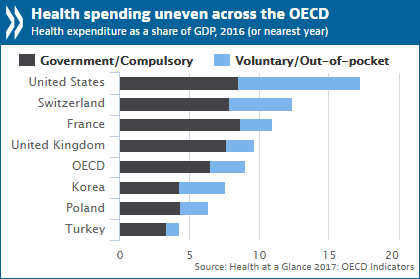Healthier lifestyles and better health policies drive life expectancy gains
Healthier lifestyles, higher incomes and better education have all contributed to boost life expectancy in recent decades. Better health care has also helped, according to a new OECD report.

Health at a Glance 2017 says that all OECD countries have seen life expectancy at birth increase by over 10 years since 1970 to reach an average of 80.6 years. Life expectancy at birth is highest in Japan (83.9 years), and Spain and Switzerland (83 years each), and lowest in Latvia (74.6) and Mexico (75).
New analysis in the report reveals that if smoking rates and alcohol consumption were halved, life expectancies would rise by 13 months. A 10% increase in health spending per capita in real terms would, on average, boost life expectancy by 3.5 months. However it is not just spending per se, but also how resources are used, that makes the difference in life expectancy. There is a large variation in the link between changes in health spending and in life expectancy: in the United States, for example, health spending has increased much more than in other countries since 1995, yet life expectancy gains have been smaller.
Health spending per capita has grown at around 1.4% annually since 2009, compared to 3.6% in the six years up to 2009. Average spending per capita has now reached about USD 4 000 per year. Spending is highest in the US, at USD 9 892 per person, and 17.2% of GDP. Health spending was also 11% or more of GDP in Switzerland, Germany, Sweden and France.
Reducing wasteful spending is key to maximise the impact of public resources on health outcomes, and Health at a Glance illustrates areas where spending could be more effective. For example:
● Over 80% of patients report positive experiences in terms of their time spent with a doctor, easy-to-understand explanations and involvement in treatment decisions.
● Avoidable hospital admissions for chronic conditions such as diabetes and asthma have fallen in most OECD countries, indicating an improving quality of primary care.
● Fewer people are dying following heart attack or stroke. Improvements are particularly striking among heart attack patients in Finland, and stroke patients in Australia.
● Across OECD countries, five-year survival rates for breast cancer were 85% and just over 60% for colon and rectal cancers, with survival rates improving in most countries over time.
While smoking rates continue to decline, there has been little success in tackling obesity and harmful alcohol use, and air pollution is often neglected:
● Smoking rates have decreased in most OECD countries, but around one in five adults still smoke daily. Rates are highest in Turkey, Greece and Hungary and lowest in Mexico.
● Across the OECD, alcohol consumption has declined since 2000. However, consumption has increased in 13 countries over the same period, most notably in Belgium, Iceland, Latvia and Poland. Moreover, one in five adults regularly binge drink across the OECD.
● 54% of adults in OECD countries today are overweight, including 19% who are obese. Obesity rates are higher than 30% in Hungary, New Zealand, Mexico and the United States.
Source: Organization for Economic Co-operation and Development
- 441 reads
Human Rights
Fostering a More Humane World: The 28th Eurasian Economic Summi

Conscience, Hope, and Action: Keys to Global Peace and Sustainability

Ringing FOWPAL’s Peace Bell for the World:Nobel Peace Prize Laureates’ Visions and Actions

Protecting the World’s Cultural Diversity for a Sustainable Future

Puppet Show I International Friendship Day 2020

